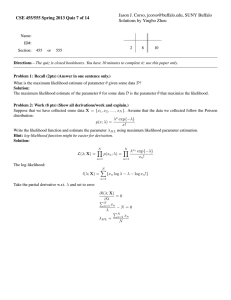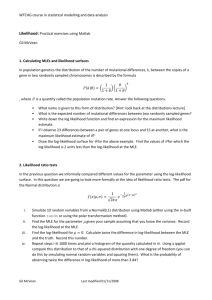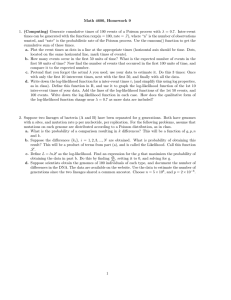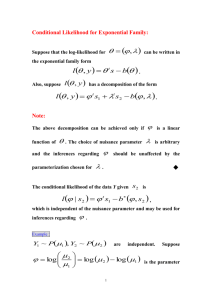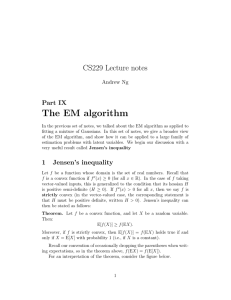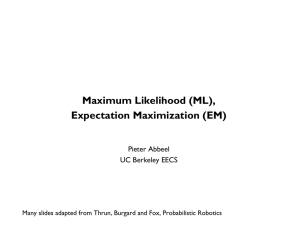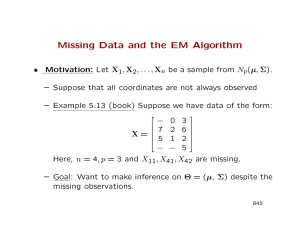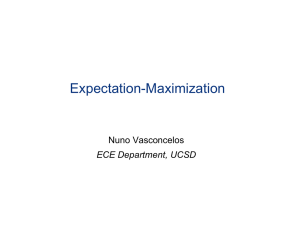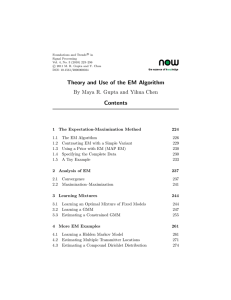EM algorithm reading group What When Why
advertisement
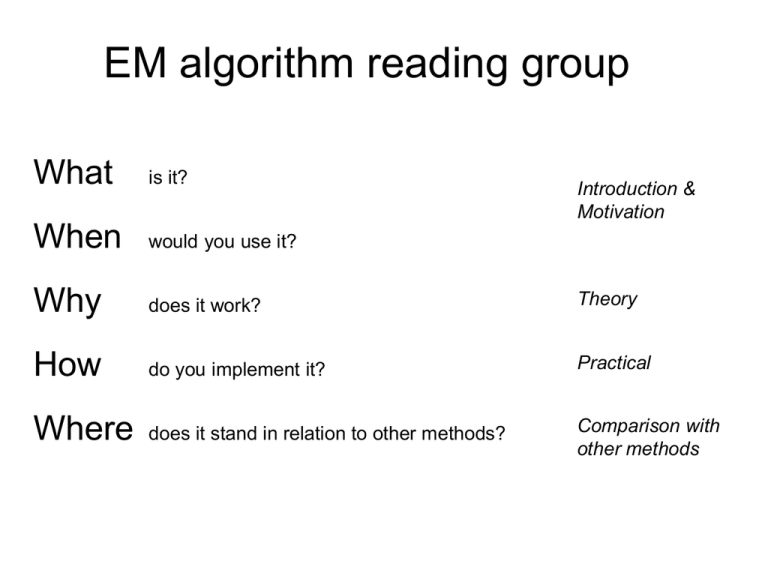
EM algorithm reading group What is it? When would you use it? Why does it work? Theory How do you implement it? Practical Where does it stand in relation to other methods? Comparison with other methods Introduction & Motivation Expectation Maximization (EM) • Iterative method for parameter estimation where you have missing data • Has two steps: Expectation (E) and Maximization (M) • Applicable to a wide range of problems • Old idea (late 50’s) but formalized by Dempster, Laird and Rubin in 1977 • Subject of much investigation. See McLachlan & Krishnan book 1997. Applications of EM (1) • Fitting mixture models Applications of EM (2) • Probabilistic Latent Semantic Analysis (pLSA) – Technique from text community P(z|d) P(w|z) P(w,d) W D W D Z Z Applications of EM (3) • Learning parts and structure models Applications of EM (4) • Automatic segmentation of layers in video http://www.psi.toronto.edu/images/figures/cutouts_vid.gif Motivating example Data: -4 -3 -2 -1 0 1 2 3 4 5 OBJECTIVE: Fit mixture of Gaussian model with C=2 components Model: where P(x|) Parameters: keep fixed i.e. only estimate x Likelihood function Likelihood is a function of parameters, Probability is a function of r.v. x DIFFERENT TO LAST PLOT Probabilistic model Imagine model generating data Need to introduce label, z, for each data point Label is called a latent variable also called hidden, unobserved, missing -4 -3 -2 -1 0 1 2 3 4 5 Simplifies the problem: if we knew the labels, we can decouple the components as estimate parameters separately for each one c Intuition of EM E-step: Compute a distribution on the labels of the points, using current parameters M-step: Update parameters using current guess of label distribution. E M E M E Theory Some definitions Observed data Continuous I.I.D Latent variables Discrete 1 ... C Iteration index Log-likelihood [Incomplete log-likelihood (ILL)] Complete log-likelihood (CLL) Expected complete log-likelihood (ECLL) Lower bound on log-likelihood Use Jensen’s inequality AUXILIARY FUNCTION Jensen’s Inequality Jensen’s inequality: For a real continuous concave function 1. Definition of concavity. Consider then 2. By induction: for Equality holds when all x are the same and where EM is alternating ascent Recall key result : Auxiliary function is LOWER BOUND on likelihood Alternately improve q then : Is guaranteed to improve likelihood itself…. E-step: Choosing the optimal q(z|x,) Turns out that q(z|x,) = p(z|x,t) is the best. nComponents x nPoints matrix (columns sum to 1): Component 1 Component 2 Responsibility of component for point : Point 6 Point 2 Point 1 E-step: What do we actually compute? M-Step Auxiliary function separates into ECLL and entropy term: ECLL Entropy term M-Step Recall definition of ECLL: From previous slide: Let’s see what happens for From E-step Practical Practical issues Initialization Mean of data + random offset K-Means Termination Max # iterations log-likelihood change parameter change Convergence Local maxima Annealed methods (DAEM) Birth/death process (SMEM) Numerical issues Inject noise in covariance matrix to prevent blowup Single point gives infinite likelihood Number of components Open problem Minimum description length Bayesian approach Local minima Robustness of EM What EM won’t do Pick structure of model # components graph structure Find global maximum Always have nice closed-form updates optimize within E/M step Avoid computational problems sampling methods for computing expectations Comparison with other methods Why not use standard optimization methods? In favour of EM: • No step size • Works directly in parameter space model, thus parameter constraints are obeyed • Fits naturally into graphically model frame work • Supposedly faster Gradient Newton EM Gradient Newton EM Acknowledgements Shameless stealing of figures and equations and explanations from: Frank Dellaert Michael Jordan Yair Weiss
